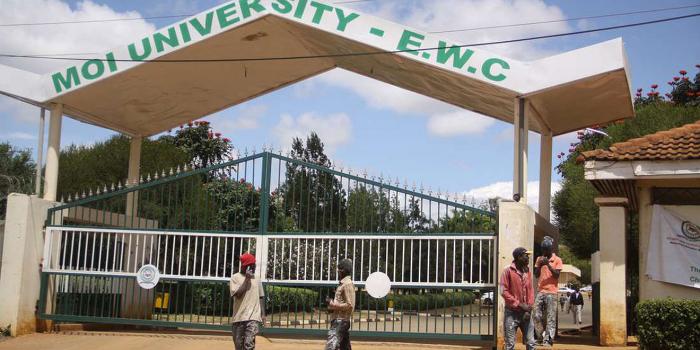
Moi University has issued a redundancy notice to employees due to financial constraints caused by declining student enrollment and reduced government funding. The affected employees, mainly members of the University Academic Staff Union (UASU), will receive severance benefits.
Moi University, one of Kenya’s largest public universities, has announced its decision to lay off employees due to financial difficulties. In a notice issued by Vice Chancellor Prof. Kiplagat Kotut, the university cited a decrease in student enrollment and a reduction in government funding as the primary reasons for this drastic move. The announcement has sparked concerns among employees, students, and stakeholders about the future of the institution and the broader higher education sector in Kenya.
Understanding Moi University’s Financial Struggles
1. Decline in Student Enrollment
One of the major reasons for Moi University’s financial struggles is a significant decline in student enrollment. In the 2024/2025 academic year, the university admitted only 6,000 first-year students, compared to a capacity of 14,000. This decline means reduced tuition revenue, which is crucial for covering operational costs, including employee salaries.
2. Reduction in Government Funding
Kenyan public universities rely heavily on government funding to support academic programs. Traditionally, government subsidies covered about 80% of the university’s academic program costs. However, recent budget cuts have seen this support drop to about 38%, leaving institutions like Moi University struggling to bridge the funding gap.
3. Accumulated Debt and Poor Financial Management
Moi University has reportedly accumulated a debt of approximately KSh 8 billion. Financial mismanagement, failure to remit third-party payroll deductions, and defaulting on loans have exacerbated the situation. The institution has also struggled to pay employees on time, contributing to growing unrest among staff members.
Details of the Redundancy Notice
The redundancy notice issued by Vice Chancellor Prof. Kiplagat Kotut highlights the need for workforce adjustments to ensure the university’s financial sustainability. The affected employees, primarily members of UASU, will receive severance pay, salary in lieu of notice, accrued leave days, and any other unpaid benefits.
During the notice period, the university management has committed to engaging in consultations with employees and union representatives to ensure a fair and legal process. However, concerns remain about the long-term job security of the remaining staff and the university’s ability to maintain academic standards with a reduced workforce.
Impact of Redundancy on Employees and Students
1. Job Loss and Economic Uncertainty
For affected employees, job loss means financial instability and challenges in finding new employment opportunities. Some staff members have worked at the institution for decades, making the sudden redundancy particularly devastating.
2. Increased Workload for Remaining Staff
With fewer employees, the workload on the remaining staff members is expected to increase. This could lead to burnout, decreased productivity, and a decline in the quality of education offered at Moi University.
3. Disruption in Academic Programs
The layoff of lecturers and other essential staff members may lead to delays in academic programs, reduced course offerings, and a negative impact on the overall learning experience for students.
4. Socioeconomic Impact on the Community
Moi University plays a significant role in the local economy by providing employment and business opportunities to surrounding communities. A reduction in staff means less spending power in the region, potentially affecting businesses that rely on the university’s employees and students for revenue.
Historical Context: Previous Workforce Adjustments
This is not the first time Moi University has resorted to staff reductions as a cost-cutting measure. In the past, over 300 contract workers in security, cleaning, hostels, and the library departments were dismissed due to financial constraints. The move was met with criticism, especially from employees who had worked at the university for over 20 years.
Government and Stakeholder Reactions
1. Response from UASU and Employee Unions
The University Academic Staff Union (UASU) has expressed concerns over the redundancy process. The union has demanded transparency in selecting employees for redundancy and has called for fair labor practices. There are also calls for the university to explore alternative cost-cutting measures instead of mass layoffs.
2. Government’s Stance on University Funding
The Kenyan government has acknowledged the financial difficulties facing public universities. The Ministry of Education has proposed new funding models, including performance-based funding and encouraging institutions to seek alternative revenue sources.
3. Community Concerns
Local leaders and community members have voiced their concerns about the economic implications of the layoffs. Many businesses in Eldoret and surrounding areas depend on the university for their livelihood, and mass layoffs could have a ripple effect on the local economy.
The Future of Higher Education in Kenya
Moi University’s redundancy crisis highlights broader challenges facing Kenya’s higher education sector. Public universities must adapt to changing economic realities by embracing financial sustainability strategies. Without urgent reforms, more institutions may face similar financial crises, jeopardizing the country’s ability to provide quality higher education.
Read: KUCCPS Application Process: Step-by-Step Guide for Applicants
Conclusion
Moi University’s decision to declare redundancy is a stark reminder of the financial difficulties facing Kenya’s public universities. While the move may be necessary for the institution’s survival, it has significant implications for employees, students, and the local economy.
To prevent similar crises in the future, Moi University and other higher education institutions must explore innovative revenue-generating strategies, improve financial management, and engage stakeholders in decision-making processes. The government also has a crucial role in ensuring sustainable funding for public universities to protect the future of higher education in Kenya.





